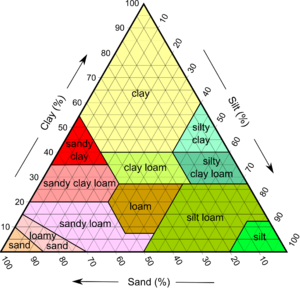Loam: Difference between revisions
Jump to navigation
Jump to search
No edit summary |
No edit summary |
||
| Line 1: | Line 1: | ||
Loam is a type of soil comprised of varying proportions of sand, silt, and clay. | Loam is a type of soil comprised of varying proportions of sand, silt, and clay. | ||
== | ==Physical Properties== | ||
[[File:Soil texture triangle.png|thumb|Photo courtesy of USDA Horticulture and soil science wiki]] | [[File:Soil texture triangle.png|thumb|Photo courtesy of USDA Horticulture and soil science wiki]] | ||
As seen in the figure to the right, the three type of soil can be combined in different amounts to form varying types of loam. The particle sizes range from large to small starting with sand, which is defined as having a particle size greater than 63 µm, silt, with a particle size greater than 2 µm, and clay, with particle sizes smaller than 2 µm. [1] | As seen in the figure to the right, the three type of soil can be combined in different amounts to form varying types of loam. The particle sizes range from large to small starting with sand, which is defined as having a particle size greater than 63 µm, silt, with a particle size greater than 2 µm, and clay, with particle sizes smaller than 2 µm. [1] | ||
Revision as of 17:25, 19 April 2018
Loam is a type of soil comprised of varying proportions of sand, silt, and clay.
Physical Properties

As seen in the figure to the right, the three type of soil can be combined in different amounts to form varying types of loam. The particle sizes range from large to small starting with sand, which is defined as having a particle size greater than 63 µm, silt, with a particle size greater than 2 µm, and clay, with particle sizes smaller than 2 µm. [1]
Life within the soil
References
1. Kaufmann, Robert K.; Cutler J. Cleveland (2008). Environmental Science. McGraw-Hill. pp. 318–319. ISBN 978-0-07-298429-3.